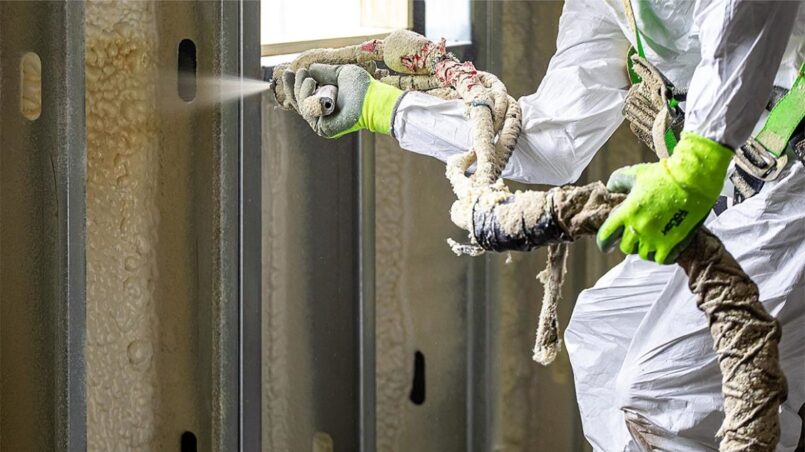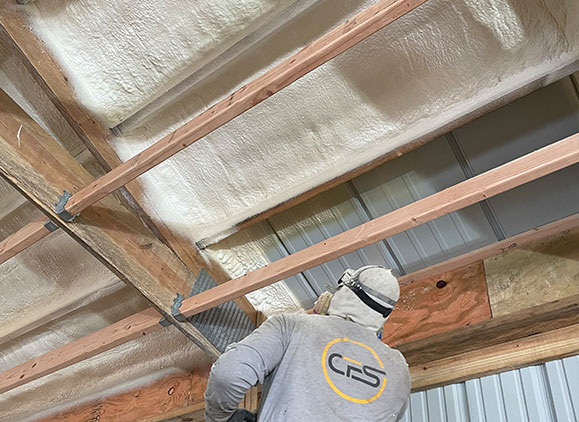You’ve likely encountered spray foam insulation if you’ve researched insulating your home. The installers make some lofty claims about its insulating abilities. They tout it as the most efficient and advanced insulation you can get. But is it all it’s cracked up to be? I decided to dig into the details to find out.
An Intriguing Option
When I started shopping for insulation, spray foam caught my attention immediately. It sounded almost too good to be true. The installers claimed it insulates better than fiberglass batts and expands to fill gaps and prevent air leaks. I was skeptical but also intrigued.
My research taught me that spray foam insulation starts as a liquid. The installers spray it into the cavities of your walls, ceiling, attic, etc. As it dries, it expands and hardens into a solid foam that adheres tightly to framing and surfaces. This helps stop leaks that rob your home of comfortable, conditioned air.
The more I learned, the more I realized spray foam might be an intelligent option for my home. But I still had some lingering questions. Namely, does it insulate as well as advertised? Is it worth the higher cost compared to fiberglass? I decided to dig deeper to satisfy my curiosity.
Assessing the R-Value
When it comes to insulation, R-value is the critical measurement of efficiency. It indicates the material’s ability to resist heat flow. The higher the R-value, the better the insulating performance. Most fiberglass batt insulation has an R-value around R-13 to R-15. Standard spray foam comes in at around R-6 per inch.
At first glance, that might make it seem like fiberglass is a better insulator. But here’s the thing – spray foam expands and seals. So, a 3-inch layer has an R-value of R-18. That puts it on par with or better than typical fiberglass batts.
Also Read: 11 REASONS TO CONSIDER REMODELING YOUR HOME
Some high-density spray foam formulations have even higher R-values, ranging from R-6 to R-8 per inch. So, with a 3-inch application, you can achieve R-21 or more. By comparison, the highest fiberglass batt rating is only around R-15 to R-21.
Already, this was telling me that spray foam likely provides superior thermal performance. But the R-value doesn’t tell the whole story on its own.
Stopping Air Leaks
Here’s where spray foam starts to stand apart. Those tiny gaps around outlets, joints, and penetrations might not seem a big deal. But air leaks can decrease your insulation’s effectiveness by up to 50 percent!
Spray foam’s expanding nature allows it to find and seal these leaks as it cures. Fiberglass insulation sits limply, with air swooshing through and around it. That warm air escaping means you must spend more on heating and cooling to maintain comfort.
Not only does spray foam stop these air leaks, but it also forms an airtight seal on the entire surface of your wall cavities or attic. The solid foam mass resists convection currents that carry heat through traditional fiberglass batts.
I even learned you can use a thermal imaging camera to see these differences in action. It will reveal all those hidden air leaks causing heat loss in walls insulated with fiberglass. But spray foam shows up as a uniform surface without leaks.
Real-World Performance
Seeing the R-value ratings and air sealing abilities convinced me about spray foam’s efficiency. But I wanted some real-world feedback.
So, I talked with several homeowners who used spray foam to discover their experiences. Nearly all said their energy bills dropped noticeably after adding spray foam insulation. Most reported 20-30% or more savings on heating and cooling costs.
One homeowner named James did a split test, insulating half his attic with spray foam and half with fiberglass. He found the attic section with spray foam stayed much more comfortable and required far less energy to heat and cool. The section with fiberglass batts still felt drafty.
Those real-world results make it hard to deny spray foam’s effectiveness. It insulates, air seals, and blocks thermal bridging all in one application. It outperforms typical fiberglass in actual homes, which supports the manufacturer’s claims.
A Sound Investment
At this point, I was convinced of the spray foam’s superior insulating performance. But it does carry a higher upfront cost, which gave me pause. The average job costs $1,200 to $1,500 for a 1,500-square-foot home. Fiberglass runs about half as much.
While no one likes an outsized price tag, I realized spray foam’s energy savings mean it pays for itself fairly quickly. If you save 30% on energy bills, it balances out the costs in just a few years. And it should keep saving year after year for the life of your home.
Moreover, it enhances comfort and reduces outside noise transmission. It’s unlikely fiberglass insulation could provide the same 20 or 30-year lifespan either. Over time, it can settle and leave gaps at the edges.
Spray foam seems like a sound investment in the long-term cost-benefit ratio. The initial outlay buys you decades of lower energy expenses and added comfort.
Weighing the Pros and Cons
To summarize my key takeaways, spray foam insulation offers meaningful benefits:
Pros:
- Higher R-value and thermal resistance than standard fiberglass batts
- Expands to fill gaps, seal leaks, and prevent convection
- Reduces heating/cooling costs by 20-30% for most homeowners
- It provides excellent noise-damping qualities
- Long-lasting, stable installation without shrinkage issues
Potential Cons:
- Higher upfront installation cost
- Requires special equipment and contractor installation
- It can be prone to moisture issues if improperly installed
- It makes future modifications slightly more difficult
- Needs extra prep work in existing homes before installing
There are certainly advantages and disadvantages to weigh. But I believe the pros heavily outweigh the cons, making spray foam the better choice.
Does It Live Up to the Hype?
After diving into the details, I can say spray foam insulation does seem to deliver on its promises. Accurate thermal performance data supports the manufacturer’s superior efficiency and air sealing claims. Homeowner experiences confirm it slashes energy costs compared to fiberglass.
Spray foam insulation exceeds traditional materials in nearly every performance category that matters. Despite the higher initial cost, it provides excellent long-term value through energy savings and comfort. It’s a wise investment for most homes. While no insulation is a panacea, spray foam comes close to living up to its lofty hype.
FAQs
Does spray foam insulation insulate better than fiberglass?
Yes, spray foam typically has a higher R-value per inch than fiberglass batts. More importantly, it air seals and resists convection for reduced heat loss. Tests and actual homeowner experience confirm spray foam lowers energy costs more than fiberglass.
How long does spray foam insulation last?
Properly installed spray foam should last at least 20 years and often 50+ years without degradation. It won’t settle over time like fiberglass and resists moisture and pests. The closed-cell structure is very durable.
What are the downsides to spray foam insulation?
The main downsides are the higher installation cost and the need to prep existing homes thoroughly to accommodate the foam. It also makes future modifications slightly harder. Poor moisture management during installation can cause problems, too.
Can you install spray foam insulation yourself?
In theory, you can rent spray foam equipment as a DIY project. However, the chemicals, safety gear, and precision application required make professional installation highly advisable for most homes.
Does spray foam insulation have any risks or downsides?
Properly installed foam is inert, non-toxic, and safe. Off-gassing during curing can be an irritation but poses no significant health risks. Some people find the cost high, while others don’t like how it makes upgrades slightly harder. But overall, risks are minimal.
The Bottom Line
If you want to insulate your home, spray foam should be on your radar. Don’t just take the manufacturers’ word for it – look at the thermal data, ask for homeowner testimonials, and make an informed decision. For most homes, spray foam is a wise investment that delivers impressive, long-lasting energy efficiency with minimal downsides. While no solution is one-size-fits-all, spray foam insulation lives up to the hype for many modern construction and retrofit projects.














